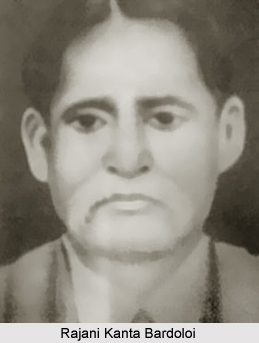 Rajani Kanta Bardoloi was responsible for bringing in a change in the Assamese novel. This is highly evident in Miri Jiyari (1895). This is his first novel. It is a romantic story with the backdrop being the tribal social environment. His other novels are romantic cum historic in theme. It has a powerful appeal and a tragic end. It has a graphic narrative and the environment is marked out with a passion. This he acknowledges in the preface to his novel Dandowa droh (1909). The greatest technical blemish of the author is his digressive departures and unwarranted compulsions of technique.
Rajani Kanta Bardoloi was responsible for bringing in a change in the Assamese novel. This is highly evident in Miri Jiyari (1895). This is his first novel. It is a romantic story with the backdrop being the tribal social environment. His other novels are romantic cum historic in theme. It has a powerful appeal and a tragic end. It has a graphic narrative and the environment is marked out with a passion. This he acknowledges in the preface to his novel Dandowa droh (1909). The greatest technical blemish of the author is his digressive departures and unwarranted compulsions of technique.
Bardoloi`s historical novels are mingled the authentic figures of history with those of his imagination. Manomati (1900) is a romantic story in the context of the Burmese invasion. The historical event of the defeat of the Assamese garrisons at the hands of the Burmese at Hadirachaki is used as a backdrop in this. The novel also has an element of suspense.
Rangili (1925) is basically a gloomy novel. The heroine symbolises patience and fortitude. The setting is that of Burmese invasion during the last decades of Ahom rule. The character of Rangili is a psychological projection of these social reflexes. Nirmal Bhakat (1926) is thematically like any Christian novel of the Oronodoi type. Dandowa droh (1909) may be described as a political novel that revolves around the peasant`s revolt of 1880 against the Ahom viceroy of Guwahati, Badanchandra. Interwoven into this is a love-story. Women characters in his novel enjoy a more illuminating focus. The other two novels are Radha Rukmini (1925) and Khamba am Thaibi. Khamba am Thaibi is a romantic story based on a legendary episode of Manipur.
Bardoloi`s novels are an imaginative re-creation of history. Bardoloi has a basic concept about society which is seen in his stories. His writings are inspired with a spirit of patriotism and romanticism. He loves nature as there is an inherent romantic possibility. He loves history because it is romantically attractive. He loves abnormal situations. He considers women as symbols of pristine grace and beauty. His forte lies in the development of situations in which desperate women face a crisis and resolve it with intelligence and dynamism of spirit. Bardoloi`s characters are not princes and potentates; they are mostly humble folks with their petty joys and sorrows.
His plot construction and character study are the best. He loves sensationalism as it adds rhythm to the heftiness of his stories. A formal conflict is always a part of his novel. His prose is analytical, descriptive and picturesque. It is localized and has an unconscious attachment for English syntax.



















